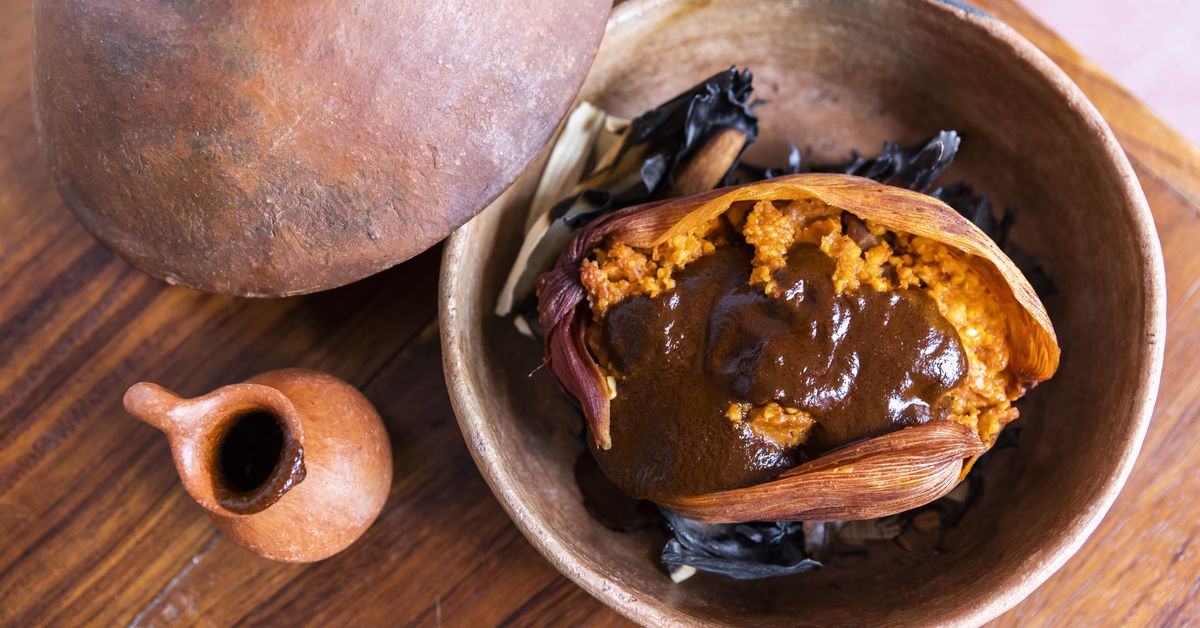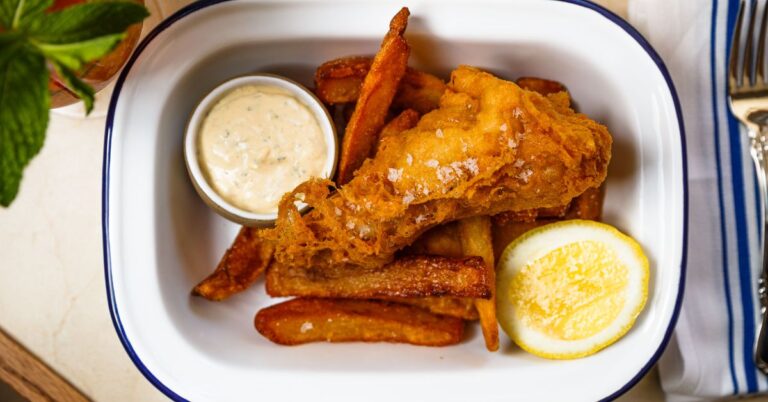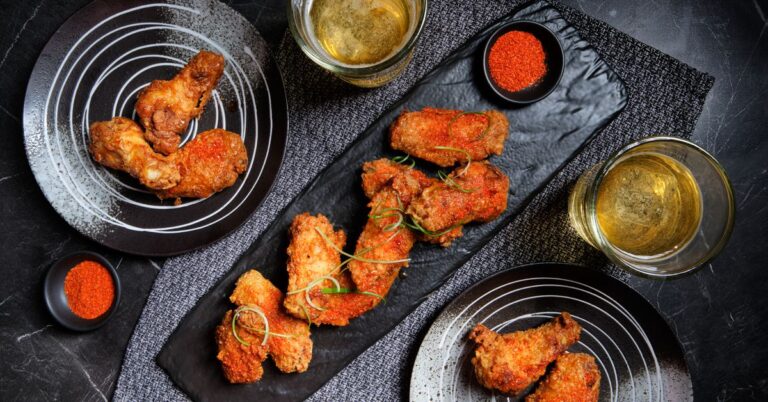The Perfect 24-Hour Food Itinerary for Oaxaca, Mexico
Oaxacan cuisine — like Oaxaca City itself — can’t be encompassed in a single day of eating, but it’s sure as hell worth a try. World-class delights exist on every corner, from sunrise to sunset, at the city’s many street-food carts, family-run fondas, coffee shops, mezcalerías, and fine-dining outposts.
Here’s how to spend an ideal, somewhat fantastical, 24 hours eating around central Oaxaca: Foam-topped chocolate, juicy tacos, corn in all its many shapes and forms, smoky salsas in stone molcajetes, pungent fermented fruits, and of course plenty of fiery mezcal await in this epic journey along the serpentine streets of the Oaxacan foodscape.
Note: During the next 24 hours, you will mostly walk your way through different food hubs inside the city, though you might jump into a cab more than once. Put on comfortable shoes and sunscreen, and prepare to eat fearlessly.
:no_upscale()/cdn.vox-cdn.com/uploads/chorus_asset/file/23235500/memelas_dona_valle_juan.jpeg)
7:30 a.m. Market Breakfast
Start off the day at the fountain that nurtures the city itself: the massive market known as Central de Abastos. Amid the maze of stalls offering all manner of food and wares, seek out the home of Doña Vale. She earned a spot on Netflix’s Street Food for good reason: Her crisp-edged memelas are nothing short of profound, made using lard (optional), fresh cheese, and a variety of toppings like thinly sliced grilled beef or pork rib. Also try the unbeatable huevos al comal (eggs cooked on a clay comal on top of an hoja santa leaf). Be generous with the bright and chunky salsas, hand-crushed in a large stone molcajete, including a deep tomatillo-chile morita salsa and a tangy tomato and chile verde. To drink, have a warm cup of Vale’s traditional café de olla, a mild coffee drink spiced with sugar and cinnamon, or order a fresh jugo verde made with celery, parsley, pineapple, and cactus purchased from the stalls nearby.
:no_upscale()/cdn.vox-cdn.com/uploads/chorus_asset/file/23232990/CHOCOLATERIAELRITO220126_0002.jpg)
9 a.m. Atole or Chocolate
For centuries, Indigenous Oaxacans have begun their mornings not with coffee — which came with the Spanish colonizers in the 16th century — but with a thin porridge-like atole or frothy hot chocolate, both renowned for the energy they would lend to farmers and warriors and, today, you. At chef Olga Cabrera’s La Atolería, the corn-based atoles are spiced and sweetened with local ingredients such as fruits, cacao, honey, molasses, and amaranth. The red corn and pataxte atole is a particularly rare find from the highlands and rainforests of Oaxaca, where the nutty pataxte and sweet red corn (as opposed to the more neutral-alkaline flavors of white corn) grow abundantly. Grab a gluten-free cornflour bread stuffed with tropical fruit jam from Cabrera’s bakery, Masea, next door.
Chocoholics should stop by Chocolatería El Rito, a cacao paradise from third-generation chocolatier Flor Heras and one of the few places in the city that ferments, roasts, and processes the beans the traditional way from start to finish. After a hot (or cold, or frappe) chocolate, and maybe even a scoop of the truly exceptional chocolate ice cream, you undoubtedly feel what the ancients felt: an energetic push to get you through the rest of your day. Pick up some of the cacao products, like the chocolate bars and jarred moles, to take home.
10:30 a.m. Late-Morning Snack
El Sabor de Cecy is the place for all things almuerzo — literally, lunch, but often a light meal that functions as a late-morning snack. The Oaxacan-style yellow mole and chicken empanada is big enough to share, which we recommend if you want to save room for one of Cecy’s famous tortas. Filling options are endless and include a number of traditional variations, but a masterful order would include a slather of bean paste, avocado, fresh quesillo, pickled carrots, and Oaxacan-style sausage (beef sausages seasoned with fruit vinegar and spices and baked in a wood-fired oven).
11:30 a.m. Coffee Break
Ready for some more real caffeine? Onno Lonchería is one of Oaxaca’s premier coffee shops. The high ceilings, white walls, and vintage furniture make for a relaxing atmosphere in which to partake of the giant coffee menu specializing in local bean varieties and a multitude of expressions. Hot or cold, you name it, Onno probably serves it: lavender frappes, cold brew, intense espressos, as well as plenty of caffeine-free options like flavored kombuchas.
:no_upscale()/cdn.vox-cdn.com/uploads/chorus_asset/file/23232607/LEVADURADEOLLA220131_0021.jpg)
1 p.m. Lunch
Levadura de Olla strikes a rare balance between preserving ancient techniques and embracing new flavors and trends. With her roots in the Sierra Sur mountains of Oaxaca, chef Thalía Barrios takes inspiration for her vegetable-centric dishes from her family’s recipes and the ceremonial smoke kitchens of la Sierra, spotlighting the region’s native ingredients like edible flowers, wild herbs and mushrooms, as well as delicate salsas, tamales, and moles. Try the heirloom tomato salad with beetroot puree or the taco de flor de pipe, a large corn tortilla taco filled with pipe, a type of edible flower from the southern mountains of Oaxaca, sauteed with chiles. Levadura de Olla has one of the best selections of ancestral-traditional beverages, too — be sure to order at least one.
:no_upscale()/cdn.vox-cdn.com/uploads/chorus_asset/file/23232902/LEVADURADEOLLA220131_0011.jpg)
:no_upscale()/cdn.vox-cdn.com/uploads/chorus_asset/file/23232915/LEVADURADEOLLA220131_0017.jpg)
3 p.m. Cool-Off Treat
Oaxaca can get hot by early afternoon — cool off by heading to the oldest market in the city, Mercado Benito Juárez, where you can scoop up some shot-size jicaras (vessels) for pouring mezcal, wooden and clay kitchenware, woven bags, and a cool Oaxacan nieve at Nieves Chagüita, a stalwart vendor that predates the founding of the market itself in 1894. Served cold and in small cups, nieves are made from frozen, churned fresh fruit, and the texture strikes a middle point between velvety ice cream and a grainy slushy. Although the market’s original stalls have been remodeled many times in recent decades, Chagüita’s 100-year-old recipes will take you back in time. Sit at one of the tables and watch vendors and musicians coming and going while you enjoy a refreshing lime nieve, or sample the signature flavors like leche quemada con tuna (smoked milk with prickly pear), mamey, or sorbete (eggnog). For something stronger, make a beeline for Mezcalite Pop for a mezcal-infused popsicle in a loungey space. Choose from toppings like chamoy, chili salt, and sweet and sour spiced salt, along with popsicle bases like passionfruit and jamaica.
:no_upscale()/cdn.vox-cdn.com/uploads/chorus_asset/file/23232977/ELPOCITO_220131_0006.png)
4:30 p.m. Snack
Spend the early afternoon wandering the Zocalo, and stop at El Chuy, an elotes and esquites cart, for a snack and an introduction to the eye-opening insect-eating culture of Oaxaca. Elotes (cooked or grilled corn on the cob) and esquites (cooked corn kernels cut off the cob, then served in a cup or piled onto a plate of corn husks) are served here with a chapulines (grasshopper) or seasonal chicatana ant-based mayo, snowed with cotija cheese, and seasoned with worm salt or whole tiny grasshoppers. Or take a break from the busy streets of the Centro Histórico and head to the quiet residential neighborhood of Trinidad de las Huertas. Just in front of the main church you will find El Posito, a small shop that sells Oaxacan piedrazos. A piedrazo is a hard, crunchy piece of double-baked bread, almost like a crouton, that’s dunked in a kombucha-like fruit vinegar made from apples and pineapples and served with an array of pickled vegetables (carrots, potatoes, onion), a sprinkle of chili salt, and often a couple of quesillo strings. It’s distinctly Oaxacan and is as much about the texture of the just-soaked bread as it is the sweet and fermented notes of the vinegar. It’s complex, refreshing, and just filling enough to tide you over for dinner.
5:30 p.m. Pre-Dinner Drinks
No imbibable is as closely associated with Oaxaca as mezcal, and a sampling of two or three Oaxacan mezcales is a wonderful way to experience the diverse flavors of the local terroir. Located on the southern end of the Centro Histórico, Mezcalería Cuish has a selection of mezcales for all preferences, running the gamut from smooth and clean to earthy and minerally. The design of the tasting room is inspired by the rural mezcal expendios (shops) and factories where the maestros mezcaleros work and live. Sip their creations, and sink into the comfy couches for a well-deserved break.
Or if you prefer your agave spirits shaken and stirred, there’s Selva. Located not far from El Chuy’s elotes and esquites cart, on the second floor above Los Danzantes restaurant, Selva’s lush concoctions incorporate local herbs, fruits, and grains with the help of pioneering beverage director Alexandra Purcaru. The gilded Gatsby-esque room decked out in tropical plants and antiqued adobe walls, form the ideal backdrop for evening drinks, especially if you find a table on one of the two balconies overlooking the city’s pedestrian walk. Favorites include the signature Selva (mezcal, chile poblano liquor, and agave honey) as well as the Molegroni (mole negro bitters, mezcal, cassis).
Those who don’t partake in alcohol should return to Mercado Benito Juárez for Aguas Casilda, a 100-year-old family stall that specializes in serving only aguas frescas (flavored waters) made with all the fruits you can imagine. Quench your thirst with a classic agua horchata (there’s a version here with bits of cantaloupe and chopped pecans) served with prickly pear sherbet, or be more adventurous and choose one of the many unusual fruit flavors and combinations like cucumber and lime, zapote, the traditional chilacayota (a type of pumpkin), guanabana (breadfruit), or pineapple.
7:30 p.m. Dinner 1
Rodolfo Castellanos’s Origen is one of the city’s most versatile, modern, yet deeply rooted restaurants. The menu changes with the seasons, and Castellanos’s skill with Oaxacan cooking techniques, as well as his knowledge of the Oaxacan terroir, make for thrilling dishes inspired by regions throughout the state. One night might offer a green salad with agave worms and hoja santa pesto sauce; another could feature roasted duck with coloradito, curcubita squash risotto with smoked Oaxacan cheese and fruits, or plantain dumplings that transport you to the coastal region of Isthmus of Tehuantepec. Leave room for dessert — the chickpeas with panela and coconut cream is a great example of Origen’s balanced oscillation between tradition and innovation.
:no_upscale()/cdn.vox-cdn.com/uploads/chorus_asset/file/23233032/CRUDO220131_0005.jpg)
:no_upscale()/cdn.vox-cdn.com/uploads/chorus_asset/file/23233034/CRUDO220131_0014.jpg)
9 p.m. Dinner 2
Two dinners may seem like too much, but this one is a comparatively light finish — and very worth it. Crudo is the first true omakase oaxaqueño with a strong Japanese influence. In a city known for cooking styles that require hours of smoking and simmering, chef Ricardo Arellano aims to show us that there’s another side to Oaxacan food that hasn’t yet been fully explored. Herbs, insects, and chiles are presented simply and unadulterated, combined with high-quality seafood, both raw and cooked, as well as with fruit and agave ferments. The entire experience lasts almost two hours, and the vibe is appropriately relaxed and private. It’s also reservation only, so be sure to book ahead.
11 p.m. After-Dinner Drinks
Sabina Sabe is as much a library of agave and other locally made spirits as it is a prime example of Oaxacan nightlife. Sample from the impressive selection of mezcals, as well as Oaxacan corn whiskey, local craft beers, and signature cocktails made with Oaxacan ingredients in the brick-lined space. Don’t worry if the stiff drinks and dim lighting leave you flagging; late-night snacks are on the way.
12:30 a.m. Late-Night Eats
An indulgent day requires decadent late-night bites to match, and the smoky, meaty, umami-rich flavors of Oaxaca’s street food fit the bill. Located on the corner of Mina and Bustamante, Tlayudas Doña Benita is a local classic. Watch the small charcoal grill produce hundreds of crispy tlayudas that sandwich juicy meat (tasajo, chorizo, or cecina), beans, and melting cheese. Top yours with a molcajete salsa of tomatoes and chile de agua, a particularly sharp local chile.
For something a bit lighter, visit Taquería Chefinita, a bar hopper staple known for its flavorful pozole, as well as tacos and tostadas topped with tender pork meat and arguably the hottest salsa in town. Or follow the cumbia at Taquería Las Cazuelas, a 24-hour party of tacos and tortas on one of the city’s busiest avenues. A long stainless steel counter displays fillings, including lightly sauteed vegetables, like mushrooms or huitlacoche, and comforting guisados (stews) that are hearty enough to counteract the night’s indiscretions: scrambled eggs with green beans, shredded chicken with guajillo, and pollo en salsa verde (chicken in tomatillo sauce). A fat pork leg torta topped with some famed salsa is the ideal cap to a perfect day of Oaxacan eating.
María Itaka born and raised in Oaxaca, is a writer, translator and fixer focused on bridging worlds through a culture sensitive approach and creative solutions. Eva Alicia Lépiz is a photographer and educator based in Oaxaca, where she works on stories related to food and culture.







